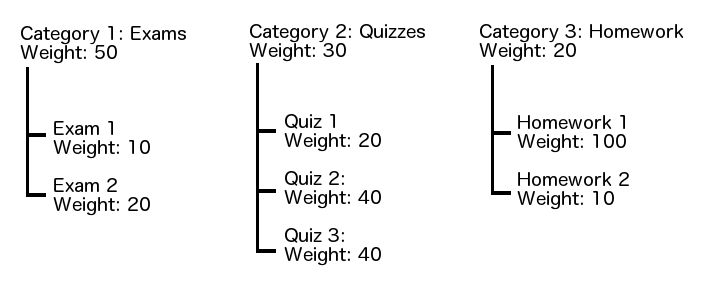Types of Grades
| Assignment Grades | A student's grade for an assignment. |
|---|---|
| Category Grades | The average of all assignments grades in a category. |
| Grade To Date | A student's current cumulative grade. Displayed as an average or sum based on Grade Calculations. |
| Class Grade | The letter grade equivalent of a student's Grade To Date. |
Grade Weighting
Assignment Weighting
Assignment weighting determines what value an assignment has in relation to other assignments. The higher the weight of an assignment, the greater worth an assignment grade has towards a student's cumulative grade. For example, if a student has three graded assignments ― two homework assignments weighing 25 each, and one exam weighing 50 ― then the homework assignments are each worth 25% of the student's cumulative grade, and the exam is worth 50%.
Total Weights
Assignments weights are relative numbers, and therefore, the total weight of all assignments does not need to equal 100. Cumulative grades will always be calculated as a percentage of the total assignment weight.
Category Weighting
Category weighting, similarly to assignment weighting, determines what value a category of assignments has in relation to other categories. Category weights are similar in function to assignment weights; the higher the weight of a category, the greater worth the assignments in that category have, collectively, towards a student's cumulative grade.
Total Weights
Similar to assignment weights, the total category weight also does not need to equal 100. Cumulative grades will always be calculated as a percentage of the total category weight.
How Assignment and Category Weighting work together
It is possible to use both Assignment and Category weights. These two features do not conflict with one another. To better understand how Assignment and Category weights work together, please refer to the example below.
You may notice that the assignment weight totals in each list (30, 100, and 110, respectively) do not match the above category weights. This is okay! Assignment weight totals and Category weights are different. Categories serve as an "umbrella" for Assignments. Each category has a weight value, but within each category, each individual assignment also has its own weight value.
That is to say, in the example above, even though Exams are worth 50% of a student's overall grade (Exams weight 50 out of a Category weight total of 100), a grade for Exam 1 only accounts for 1/3 of that 50 weight value. (The 1/3 figure is because Exam 1 has a weight of 10, out of an Assignment weight total of 30 among the Exam assignments). That means Exam 1 is only worth 16.7% (1/3 of 50%) of a student's cumulative grade.
Likewise, even though Homework 1 has a weight of 100, it accounts for 90.9% (100/110) of the overall Homework category value of 20. Taking the calculation one step further, Homework 1 would only account for 18.2% (90.9% of 20) of the cumulative grade in this example.
Equally Weighted Categories
If you wish for all assignments within a particular category to possess the same weight, simply go to Settings > Categories, click Edit Categories, and select "Equally Weighted" in the Assignment Weights dropdown menu next to the category.
Explanation of Grade Calculations
If you have n assignments with weights w1, w2, w3, ..., wn with max points m1, m2, m3, ..., mn and a student has grades g1, g2, g3, ..., gn, then the weighted normalized average grade for a student is calculated as such for all where gk is a number (not blank or excused):
(Σk wkgk / mk) / (Σk wk) = (w1g1 / m1 + w2g2 / m2 + w3g3 / m3 + ... + wngn / mn) / (w1 + w2 + w3 + ... + wn)

